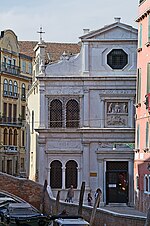Ospedale della Pietà
Buildings and structures in VeniceConvents in ItalyEducation in VeniceMusic schools in ItalyOrphanages in Italy ... and 1 more
Schools in Italy

The Ospedale della Pietà was a convent, orphanage, and music school in Venice. Like other Venetian ospedali, the Pietà was first established as a hospice for the needy. A group of Venetian nuns, called the Consorelle di Santa Maria dell’Umiltà, established this charitable institution for orphans and abandoned girls in the fourteenth century. By the seventeenth and eighteenth centuries the Pietà – along with the three other charitable Ospedali Grandi – was well known for its all-female musical ensembles that attracted tourists and patrons from around Europe.
Excerpt from the Wikipedia article Ospedale della Pietà (License: CC BY-SA 3.0, Authors, Images).Ospedale della Pietà
Riva degli Schiavoni, Venice Venezia-Murano-Burano
Geographical coordinates (GPS) Address Nearby Places Show on map
Geographical coordinates (GPS)
| Latitude | Longitude |
|---|---|
| N 45.4341 ° | E 12.3446 ° |
Address
Riviera del Leon
Riva degli Schiavoni
30122 Venice, Venezia-Murano-Burano
Veneto, Italy
Open on Google Maps











